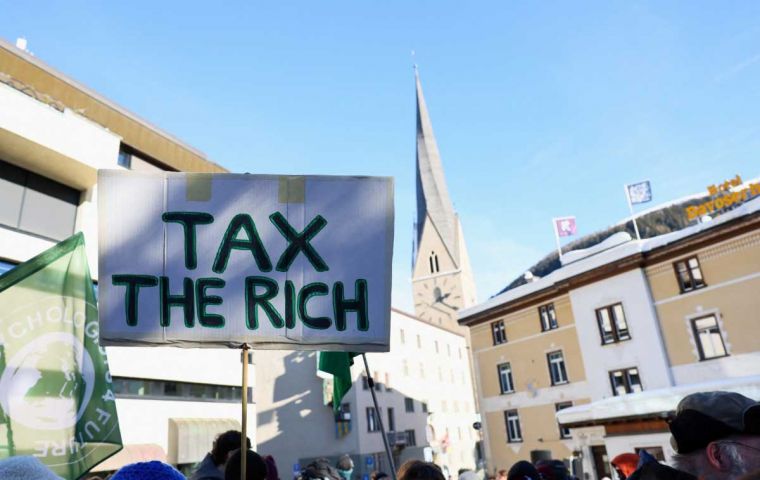MercoPress. South Atlantic News Agency
Unfair taxation in LatAm and Caribbean hits the poorest harder
 Taxes on large fortunes in the region could generate additional revenue for the region as a whole of up to US$ 264 billion, Oxfam believes
Taxes on large fortunes in the region could generate additional revenue for the region as a whole of up to US$ 264 billion, Oxfam believes A study released last week by Oxfam, a global movement seeking to end the injustice of poverty, found that the two wealthiest men in Latin America and the Caribbean owned more than 334 million others in the region.
Carlos Slim and Germán Larrea top the list of the around 98 billionaires in these parts of the world whose accumulated wealth reaches US$ 480 billion, which is tantamount to the entire annual GDP of Chile and Ecuador, the “Econonuestra” survey detected.
“What is underlining this deep inequality is that there is an ever greater concentration of wealth in the hands of 1% of the population versus the poverty that the poorest population is experiencing,” Oxfam Colombia Director Sandra Mojica told EFE.
The region “is going through multiple crises that have deepened this inequality and positioned it as the area with the greatest inequality in the world,” she added.
“Latin America and the Caribbean is the region in the world where there is the greatest polarization between the wealth concentrated by the richest 1% of the population and that which is in the hands of the poorest 50%,” reads the report released Friday in Bogotá.
Since 2000, the combined fortunes of these magnates have increased 368%, which means that it has grown six times faster than the economy of the entire region and at a rate of 43.7 million dollars a day.
In other words, “a worker with the average minimum wage in the region would have to work 90 years to earn the same as the average Latin-Caribbean billionaire earns in a single day,” the study highlighted.
Poverty in the region in 2023 reached almost 30% of the population, (around 183 million people), and extreme poverty reached higher levels than in 2010.
“These millionaires are concentrating the greatest amount of wealth while the poorest people do not even manage to concentrate 1 dollar out of 100 dollars of wealth generated,” Mojica also noted. This phenomenon stems from most tax systems in the region favoring “the richest and most powerful and not the population.”
In most countries, millionaires and companies lobby for “measures that favor redistribution that prevent States from having the autonomy to take measures that benefit the population,” she elaborated.
“It is not that wealth is not generated in the region, it is not that there are no resources in the region, it is that the way these resources are being redistributed in the region is generating these deep inequalities,” Mojica insisted.
According to Oxam, public policies aimed at reducing intersectional inequalities that prioritize income, access to health, and education are needed to close the inequality gap. But this entails “high public investment in universal services that guarantee basic rights in an egalitarian manner.” Taxes on large fortunes in the region could generate additional revenue for the region as a whole of up to US$ 264 billion.
Oxfam also supports tackling climate change affecting the poorest while promoting “co-responsibility for care work,” which historically has been undertaken by unpaid women.
Another Oxfam study released in January found that the wealth of the five richest men on earth had increased by 114% while almost 5 billion people went poorer since 2020.




Top Comments
Disclaimer & comment rulesCommenting for this story is now closed.
If you have a Facebook account, become a fan and comment on our Facebook Page!